Grilled Salmon Collar with Ponzu Sauce
July 24, 2012 | Updated May 26, 2020
As an Amazon Associate I earn from qualifying purchases.

Every few years California gets a great salmon season, and when that happens we eat a lot of salmon. On the boats I fish, I see lots of people getting their fish filleted and happily walking away with slabs o’salmon.
They’re happy, but I can’t help but feel sorry for them: They just left the best part of the salmon with the deckhand: the salmon collar.
I’ve been a deckhand before, and I know that what the clients leave behind is often the best part of the fish. In no case is this more stark than with salmon collars.
What is a fish collar? It is the part of the fish behind the head and gills that extends to where you sliced off the fillet. It includes the pectoral fins. If you’ve ever eaten hamachi kama at a sushi restaurant, that’s the collar from a yellowtail jack.
Why bother with it? Well, it is insanely rich, meaty and just plain fun to eat. Lots of rich, fatty meat nestles in pockets around the fins, and then you get some regular meat at the top of the collar that you missed with the fillet knife. In all honesty, I’d rather eat collars than the regular fillets.
Only bother with collars from fish about 5 pounds or larger; anything smaller is not worth the trouble.
You remove the collar after you’ve filleted the fish. Do this with a knife and/or a pair of kitchen shears. The best way is to fillet your salmon from right behind the head, taking the collar with you. Then, you slice off the collar from just behind the pectoral fin.
Salmon collar is made for grilling. I cook them in no other way, although you could broil them if you don’t have access to a grill.
I’ve cooked them barbecue style, with indirect heat, as well as straight over the coals. I actually prefer a little char (oooh, fish pun!) that I get with the direct heating method. Indirect heat limits the charring, but the collars can stick to the grill more that way. Your choice.
A marinade is a good idea. Why? Because the collar isn’t very thick, so a marinade can penetrate quickly, giving you a boost of flavor. What I provide below is a pretty traditional hamachi kama marinade, but let yourself run free. Your mind is your only limitation here.
Dipping sauce? Traditional, but not vital. I’ve eaten collars both ways. Ponzu, a citrus-soy blend, is a great idea for salmon, because it’s so rich. You might want a sauce with a little fat in it if you were to grill a collar from a lean fish, such as a lingcod or striped bass.
Grilled Salmon Collar
Ingredients
- 4 salmon collars or collars from another large fish
- 1 tablespoon sesame oil
- 1/4 cup soy sauce
- 1/2 cup mirin or rice vinegar mixed with 2 teaspoons sugar
PONZU
- 1/3 cup lemon juice
- 1/3 cup lime juice
- 1/3 cup orange juice
- 1 cup soy sauce
- 1/4 cup rice vinegar
- 1/4 cup mirin
Instructions
- Put the sesame oil, soy and mirin in a container and toss with the salmon collars. Cover and marinate for at least 20 minutes, but 2 hours is better. You can marinate them as long as overnight, but more than that and the fish will get too salty.
- While the fish is marinating, mix all the ingredients for the ponzu sauce and set aside.
- Get your grill going. Wood is the best here, but charcoal or gas works fine, too. You want medium heat for fatty fish like salmon or yellowtail, hotter heat for a lean fish like a lingcod. The fat in the fish protects it from overcooking. Make sure your grill grates are hot, and spotlessly clean. Drain the fish collars from the marinade and allow to drip any excess away; this helps prevent flare-ups. Right before you set the fish on the grill, ball up a paper towel and grab it with tongs. Dip the paper towel in vegetable oil and wipe down the grill grates.
- Lay the fish on the grill skin side down. Cover the grill and cook until the skin side gets a little charred and a lot crispy. This should be at least 3 minutes, but if you have your heat at a nice medium, it will be closer to 5-6 minutes. Carefully flip the collars with a large metal spatula and cook for another 4-6 minutes on the meat side.
- Serve with steamed rice and the ponzu sauce on the side.
Notes
Nutrition
Nutrition information is automatically calculated, so should only be used as an approximation.

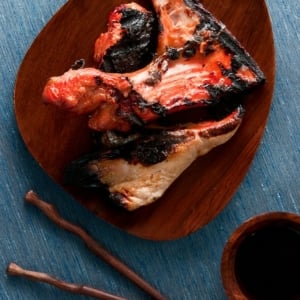
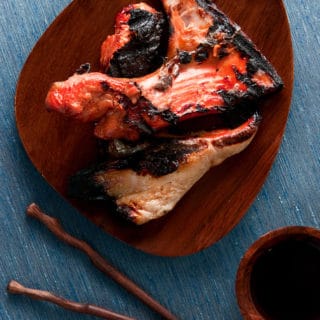
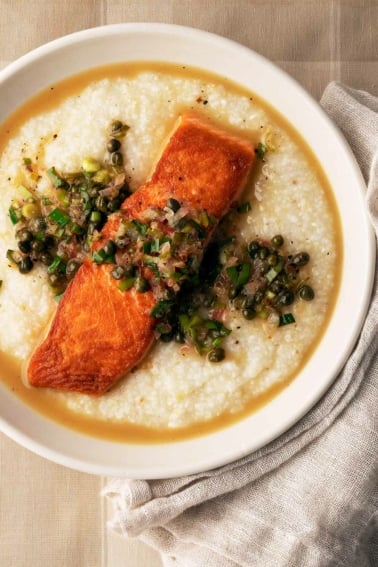
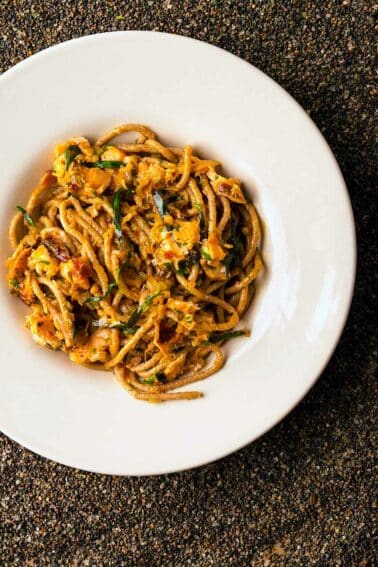
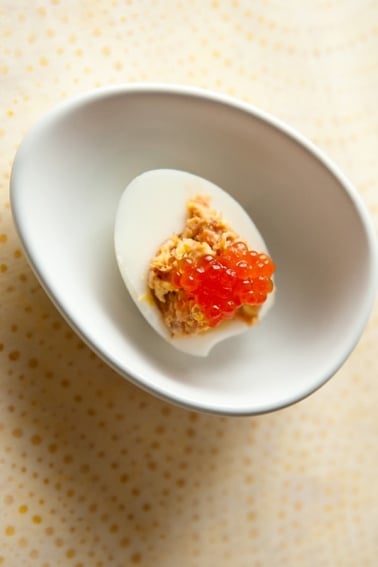

Salmon Collars and Halibut Cheeks. People are missin the good stuff!
Hank, can you recommend a salmon fishing guide service for an ocean trip?
Thanks,
Gary
Gary: Where?
In step #4 what do you mean skin side out ?
Out toward you ?
Peter: Should be skin side down. Sorry!
Hank, Have you ever tried fermenting you own soy sauce? If so dou you have a recipe?
Wow, great stuff! We’re salmon fishing guides on Oregon’s south coast Rogue River. We grill the frames & bellies and the usual filet’s, but have never considered the collar. Will check it out and get back !
Hank,
I have some Pacific yellowtail collars from San Diego. How long would you marinade them? Would you add fat to the Ponzu? What kind?
Thanks!!!!
We’re able to buy big salmon heads at our local Asian market and removing the collars to grill is a fast, weeknight staple. We do them the classic Japanese way. I separate the two lower jaws from the main neck piece and then separate the neck piece along the bone. Then I give them a good even coating of kosher salt and grill on direct heat until each side is crispy with golden brown spots. Serve with rice and ponzu. Mmmmm,
Yum! Another good use for an often wasted resource. Can’t wait for salmon season. After a successful day of fishing for stripped bass or salmon, our traditional dinner is fried fish bones. Just dredge in flour, season with salt and pepper, and fry in olive oil. Eat it right off the bones like corn on the cob. We’ve even served it to company.
Don’t forget about the fish cheeks either , Best part of the fish as far as I am concerned !
Man that salmon sure is good, just got done cooking it. Thanks for the recipe.
I have never had the good fortune to catch a wild pacific salmon, so I’ve never given salmon collars a try, but I’ve never encounter a fish collar I didn’t love. White seabass collars are so oily that they end up almost tasting like grouper. The collar on a big lingcod is the best part of the fish. Thanks for spreading the word on this delicious and oft-discarded part of our catch!
I always keep my fish collars attached to the filleted body of the salmon and then smoke the whole fish carcass for 1-4 hours. I then make smoked salmon pasta or smoked salmon & bagels with the smoked meat. If I am on a charter and other clients decide to not take the carcass, I always ask if I can have them for fish head soup, but always end up smoking them instead. Another time while charter fishing for Halibut, the deckhand filleted all the fish and was about to dump all the carcasses back into the ocean before I said, “No way Jose!”. I took all the halibut bodies home and carefully removed the precious halibut scallops or cheeks as many of you might know them. The rest of the bodies went into making halibut fish soup stock. Great fish is a terrible thing to waste! Like our ancestors, using all or as much of the animal that sacrificed it’s life so that you could continue living is the most respectful things you can do.
Yum! I’ve never had salmon collar, but I love yellowtail collar!
Sounds great and will have to try grilling some BC Chinook collars. We typically smoke the collars around here. The oil in this part of the salmon takes smoking quite well. We also smoke big ling cod collars.
One of my favorite collars is from Redfish…just delightful!
Now I’m anxious to try one of these collars!–I always learn something new from you.
Hank,
I was lucky enough to be invited to a friend’s annual birthday event this spring. His father buys a striped bass fishing charter on the Chesapeake Bay most years and lets him and his twin brother each bring a friend. At the end of the day, we had two fish, a slow day unfortunately, as the limit during the trophy season is two fish per person over 28 inches. When we reached the dock, my friend’s dad asked the mate to fillet the fish for them. I jumped at the opportunity to take everything else- heads, spines, and tails from both fish. These guys looked at me like I had two heads. I finished cleaning them up when we got home and froze everything.
I had freshly prepared fish head soup while sailing off the coast of Turkey eighteen years ago. That experience convinced me to save most everything from a fish from that point on.
The mate on the charter boat missed enough meat on those rockfish for a hearty fish head soup!
When I thaw them out I’ll remove the collars and grill them per your recommendation and let you know how they turned out.
Thanks again for the great writing and commitment to using the entire animal/fish.
I love roasted tuna collar and it’s incredibly cheap to purchase ($1 /per pound in Louisville). The only problem I have had is that it really stinks up rhe house.
Hank,
Sounds great….except how do you cut out/off the collar?
That’s hilarious. I just finished putting 4 coho collars and 2 chinook collars that I caught last week off Nootka Sound into a marinade. Almost identical marinade. I like to add something sweet that carmelizes well. In this case I added a touch of maple syrup.
I’ve never done a dipping sauce though. Perhaps I will try that tonight.